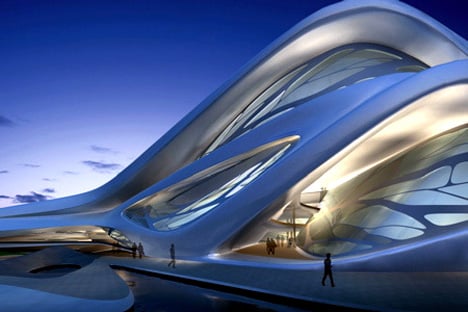Architect Aishani Jayasinghe was featured on the daily mirror w@w magazine 23-06-09. Earlier, Architects such as Professor weddikkara and Architect Nilakshi dharamawardena have been featured similarly.
By Jennifer RodrigoA parrot cannot be fed an egg instead of a mango and a snake cannot be given a mango instead of an egg; this would not be the most appropriate course of nature. Similar to the above fact, even in architecture, clients cannot be served out ideas and structures that don’t suit them and don’t cater to their comfort. This was the sentiment carried within this week’s cover personality. Meet Archt. Aishani Jayasinghe, a lady who’s happy with what she’s got in her life. “My biggest weakness, I think is that, I’m not too ambitious because I am content with all I have in my life at the moment!” she laughed.
The meeting with Aishani was couched with ease. Her parents’ pet dogs who seemed feisty on the outside but were in fact quite friendly within, sat round at our feet while we conversed. “When I approach any project, the technical aspect starts off with a brief of what the client wants. I then look at the land upon which the structure is to come up and the essence of character possessed by its surroundings. I also pay attention to the function of the place – Who’s going to occupy the place? What sort of people are they?” she explained. The final product, in Aishani’s mind is a space that’ll suit its users and provide comfort to them.
Shaping
Aishani grew up amidst the subtle yet deeply profound influence of her parents, Prof. Nimal De Silva and Iranganie De Silva, who themselves are well recognized architects in Sri Lanka. “There was nothing intentional from them that propelled me to become and architect but listening to their comments and opinions on certain designs and their general talk about architecture, I guess the interest for the field was just deposited in me when I was very young,” she recalled. There began young Aishani’s enthusiasm for the field, although the manifestation of it didn’t occur for some years to come. Her father was the Head of the Department of Architecture at Moratuwa University at that time and Aishani reflected on how much she enjoyed tagging along with him on trips and study tours he took with his students, feasting her senses in the interesting activities the students took part in. After her O/L’s which she completed at Ladies College Colombo, she chose to pursue London A/L’s privately because she was working towards the opportunity of going abroad to learn Architecture. Following her bright tenure in school, being involved in many extra-curricular activities that brought out the talent and brilliance in her, Aishani entered the University of Hong Kong in 1998 where she read for her Bachelor of Arts degree in Architectural Studies.
Her schooling years at Ladies, she describes as ‘a period of limitless possibilities for all capabilities and achievements.’ Juggling between hockey, netball, athletics, basketball, rowing, swimming and water-polo, Teak-Won-Do, Debating and Chess, while maintaining a successful academic profile, being placed within the first three in every class, Aishani seems to have gained a bountiful scope of experience. “The School recommended me to go in for law; my bio teacher wanted me to pursue genetics; but finally when it came to university, I ended up selecting Architecture for which the diverse experience and right and left brain combination was extremely useful!” she smiled. Dancing was another stream Aishani loved and she made sure she pursued that too. While she studied Kandyan and Baratha Natyam dancing from a very early age, she also competed in Ballroom and Latin American dance competitions and got placed as well.
Aishani holds a M.Sc.(Architecture) from the University of Moratuwa, where her father presently serves as the Chair Professor at the Faculty of Architecture. She also holds a Part III-Charter -AIA (SL) from the Sri Lanka Institute of Architects. Houses, housing complexes, Tourism related buildings, Government administrative buildings, religious buildings, interior designs, building renovation designs and external landscape design are some of the areas within which Aishani works. She also worked as a full time lecturer at the Faculty of Architecture in Moratuwa for a couple of years in addition to having lectured at the Academy of Digital Arts, Sri Lanka and serving as teaching assistant at Kamla Raheja Vidyanidhi Institute of Architecture (KRVIA), Bombay, India. At KRVIA, Aishani conducted research as well on the eastern water front development of Bombay.
Working at her father’s firm DEVECO architects Sri Lanka of which her mother too is partner, Aishani recollects fond memories. “I remember the first ever real thing I designed. It was when I was working at my father’s firm right after A-Levels before even entering university. It was the Bell Tower of the Naagadeepa Temple. I’m not even sure if it was built or not!” she enthused.
The eldest from a family of three, one boy and two girls, Aishani revealed that she was quite closer to her brother in age while their sister is server years younger. Nurtured amid the company of a ‘bunch of cousins’ who were predominantly male, she admits that the experience only paved way for greater confidence and strength within her. “I never felt ‘Oh, I can’t do that coz I’m a girl…’.” It seems like this feeling in Aishani travelled the length of time and resides in her even today. In a profession somewhat slanted towards the men, she voiced that when it comes to the challenge of being a female architect, it’s as challenging as being a good male architect. “If you know what you are doing, and if you have the talent, I don’t think gender matters when it comes to Architecture. What matters is how creative you are and how well you can play the professional role you need to play.” Aishani mother was the Chief Architect of the State Engineering Corporation for many years. While this was around thirty years back, when there were only a handful of female architects in the country, today, Aishani feels that there are more girls studying architecture at University than boys.
Experience
Having served as Project Architect for a numerous and varied collection of projects inclusive of Proposed Sports, Recreation and facility Building for Sri Lanka Government service sport society at Polhengoda, Proposed Youth university at Panadura, Infrastructure Development in the vicinity of Rawana Ella and Tourist Information Center in Bandarawela, she has also been in the Design Team for the Konkani Resort in Velneshwar , Rathnagiri, India, Ajanta Tourist Complex and Museum, Arungabad, India, Ellora Tourist Complex, Arungabad, India, Ajanta View Point, Arungabad, India and Mascot Hotel , Kerala –India. “I like what I do because it’s so ‘free’. It’s about conceiving a dream for someone else and making it real. You dream for others and you have the power of making it come true!” she said.
Married also to an architect, Nalin Jayasinghe, Aishani and her husband work together on some projects as well. It seemed all the more clear why her thriving interest in the field was kept alive by the company and influence of both her parents and her husband. Inspired by people, places, culture and nature for her work, Aishani explained that an architect should be able to see things without having to look, express what is felt and sensed in words, lines, motion and form, should be logical and irrational at the same time, should learn to relax in the most stressful moments and be creative rather than neurotic.
With a flexible schedule each day, Aishani admitted that she does have a variety of projects on her platter within which working as part of the Course development team for the new Architecture course which is to be commenced by the Open University of Sri Lanka, is one. “The more I have to do, the better I am at doing them!” she laughed.


 Last Saturday whilst on Galle road somewhere around Rathmalana, an idiot was honking behind me like mad. I was about to make a right, and was on the correct lane. Completely pissed off, I slowed down to see who this was. Two people completely covered with coats on a motorcycle, their gloves were the only indicator that they were traffic police. I ddint say word after seeing the gloves, and the bugger started blagarding me saying "you should move your car when WE tell you to do so... I said I was about to make a right turn. Taking no notice they continued with their verbal thrashing.
Last Saturday whilst on Galle road somewhere around Rathmalana, an idiot was honking behind me like mad. I was about to make a right, and was on the correct lane. Completely pissed off, I slowed down to see who this was. Two people completely covered with coats on a motorcycle, their gloves were the only indicator that they were traffic police. I ddint say word after seeing the gloves, and the bugger started blagarding me saying "you should move your car when WE tell you to do so... I said I was about to make a right turn. Taking no notice they continued with their verbal thrashing.














































